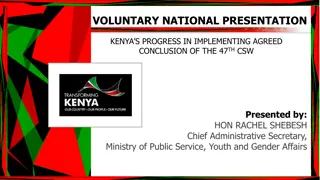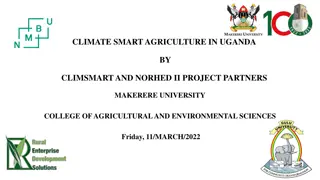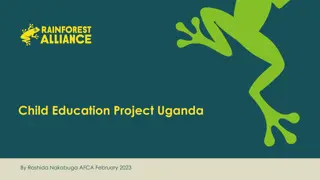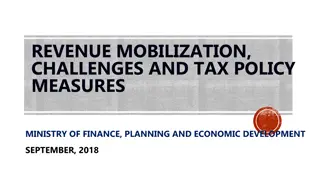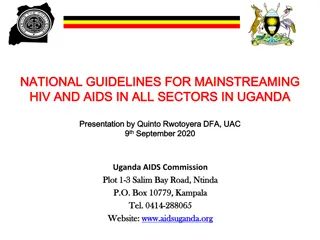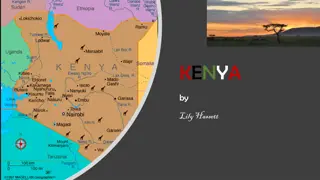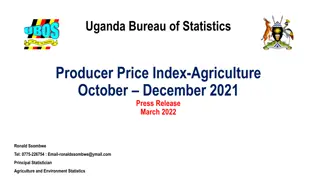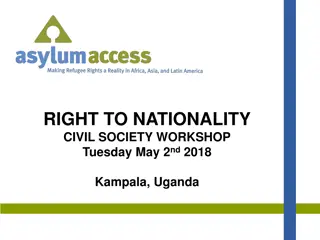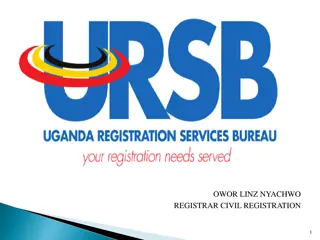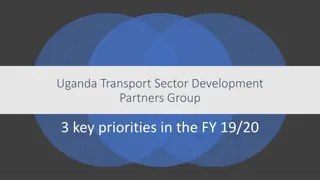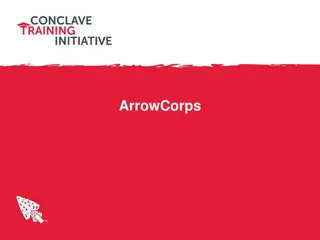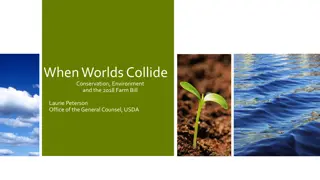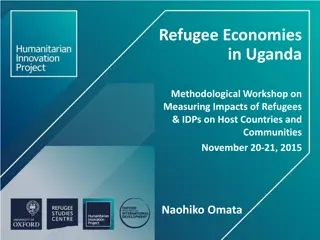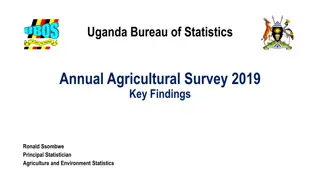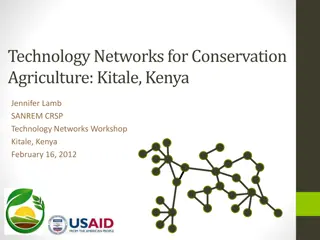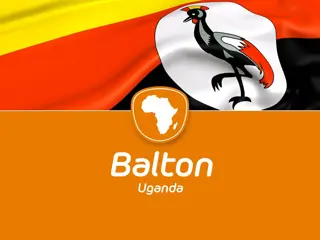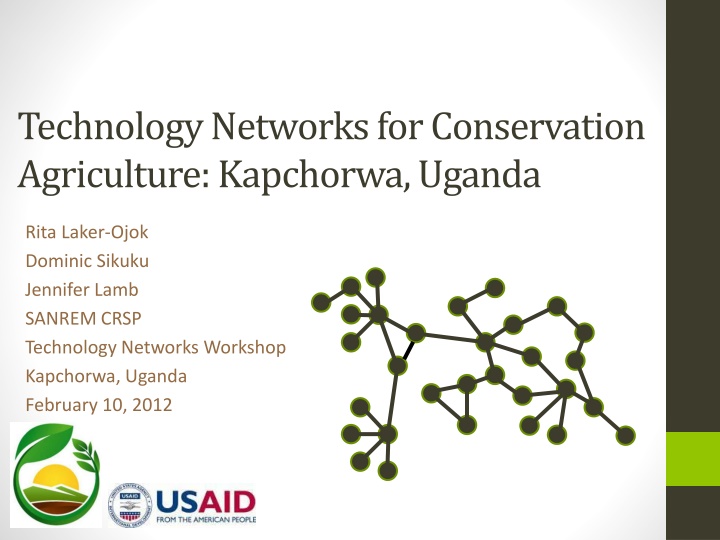
Conservation Agriculture in Uganda and Kenya
This project focuses on the development and transfer of Conservation Agriculture Production Systems (CAPS) for small-holder farms in Eastern Uganda and Western Kenya. Implemented by University of Wyoming in collaboration with Makerere University, Moi University, AT Uganda, Manor House, Sacred Africa, and local farmer groups/stakeholders, the core principles of conservation agriculture include disturbing the soil as little as possible, keeping the soil covered, and mixing/rotating crops to improve soil fertility and sustainability. By advocating reduced tillage, soil cover, and crop diversity, this initiative aims to enhance agricultural practices and promote long-term environmental conservation.
Uploaded on | 1 Views
Download Presentation

Please find below an Image/Link to download the presentation.
The content on the website is provided AS IS for your information and personal use only. It may not be sold, licensed, or shared on other websites without obtaining consent from the author. If you encounter any issues during the download, it is possible that the publisher has removed the file from their server.
You are allowed to download the files provided on this website for personal or commercial use, subject to the condition that they are used lawfully. All files are the property of their respective owners.
The content on the website is provided AS IS for your information and personal use only. It may not be sold, licensed, or shared on other websites without obtaining consent from the author.
E N D
Presentation Transcript
Technology Networks for Conservation Agriculture:Kapchorwa, Uganda Rita Laker-Ojok Dominic Sikuku Jennifer Lamb SANREM CRSP Technology Networks Workshop Kapchorwa, Uganda February 10, 2012
What is the project? Lead institution: University of Wyoming Development and Transfer of Conservation Agriculture Production Systems (CAPS) for Small-holder Farms in Eastern Uganda and Western Kenya
Who are the implementing partners? Universities: University Of Wyoming, Makerere University, Moi University Ngo s: AT Uganda, Manor House, Sacred Africa Local Farmer Groups/Key Stakeholders
Core Principles of Conservation Agriculture The three principles of conservation agriculture Disturb The Soil As Little As Possible. Keep The Soil Covered As Much As Possible. Mix And Rotate Crops.
Disturb the soil as little as possible In conventional farming, farmers plough and hoe to improve the soil structure and Control weeds. But in the long term, they actually destroy the soil structure and contribute to declining soil fertility. In conservation agriculture, tillage is reduced to ripping planting lines or making holes for planting without disturbing the rest of the field. The ideal is to plant direct into the soil, without ploughing.
Keep the soil covered as much as possible In conventional farming, farmers remove or burn the crop residues or mix them into the soil with a plough or hoe. The soil is left bare, so it is easily washed away by rain, or is blown away by the wind. In conservation agriculture, crop residues left on the field, mulch and special cover crops protect the soil from erosion and limit weed growth throughout the year.
Mix and rotate crops In conventional farming, the same crop is sometimes planted each season. That allows certain pests, diseases and weeds to survive and multiply, resulting in lower yields. In conservation agriculture, this is minimized by planting the right mix of crops in the same field, and rotating crops from season to season that require different nutrients from the soil. This also helps to maintain soil fertility.
SANREM Principles and procedures In working with our partners in the farming communities we have targeted for conducting research for the development of adapted Conservation Agriculture Production Systems (CAPS) we need to understand the value of our activities for community members, and how they perceive the benefits of what we are learning. That is why we have created a local advisory council this is why you are here today.
Principles and procedures This is a research project. Our objective is to develop new knowledge that can be used by local partners to improve their production systems, and consequently their livelihoods and well-being. We do not have the necessary resources to deliver the inputs and means for achieving development. We are in the community to learn from community members and about their production systems. In the process, we should be helping the community learn more about their own resources and potentials and how they can build more sustainable and profitable production systems.
Principles and procedures This project conducts research with individuals and communities is on a voluntary basis. Successful learning occurs when individuals choose of their own accord to think and act in new ways. Our job is to present and test new ideas and technologies with those communities and community members who are interested in actively learning about new ways to manage their resources.
Where we are in the process This is a 4 year project. We have 3 years left. We have done the baseline data collection to understand the local production system before the project, and to try to understand what people s thinking about CA was before we started. Today s presentation is to show you some of the results of that baseline study. We have also completed the first year of experimental trials to begin testing CA principles in Uganda and those results are being analyzed. They will also be shared with you soon.
Introduction Successful Conservation Agriculture requires: Broad based support network Change in mindset regarding agricultural production practices Everyone has to be involved Why we have tried to bring you all here today The plow is a familiar sight in Kapchorwa
Research Process Focus Groups in 2010 Identify key contacts for agricultural production List of 19 key actors Survey conducted in 2010 97 farm households were asked about their key contacts for agricultural information/resources in Kwosir Sub-county Kwosir and Kere Parishes Follow up interviews conducted in 2011 with 19 individuals Community agents Agricultural service providers
Research Aims Understand existing mindsets with regard to agricultural production Especially with regard to conservation agriculture Map the structure of agricultural production networks in Kapchorwa Prioritized Identifying: Key nodes in the network For farmers In the whole agricultural production network Knowledge and beliefs about CA Differences between farmers and service providers/community agents
Farmer Involvement in Agricultural Networks Standard Deviation Min Value Max Value Variable Observations Mean Resource Contacts 97 3.65 2.53 0 10 Information Contacts 97 7.12 3.72 0 17
Key Resource Contacts for Farmers Agent Type: Number of Reports (Out of 97): Percentage of Farmers Reporting Contact: 58 53 37 36 36 34 31 25 11 8 7 7 4 3 3 2 0 0 0 60% 55% 38% 37% 37% 35% 32% 26% 11% 8% 7% 7% 4% 3% 3% 2% 0% 0% 0% Veterinary Service provider Vendor in a agro-vet shop Neighbor/friend Family Member NGO/ Development Agent Vendor in weekly market Tractor owner/ animal traction provider Government Extension agent Agricultural researcher Leader of farmer organizations Vendor in a shop in urban center Agricultural/Micro Finance Representative Village/Subcounty chief Teacher in village Leader of women s organization Minister/Priest/Imam in village Government Parastatals Leader of youth organisation Local Political leaders
Key Information Contacts for Farmers Number of Reports (Out of 97): Percentage of Farmers Reporting Contact: Agent Type: 81 72 62 57 53 52 42 40 36 34 34 33 32 23 13 12 9 5 1 84% 74% 64% 59% 55% 54% 43% 41% 37% 35% 35% 34% 33% 24% 13% 12% 9% 5% 1% Family Member Neighbor/friend Veterinary Service provider Vendor in a local agro-vet shop Vendor in a shop in urban center Vendor in weekly market Tractor owner/ animal traction provider Government Extension agent NGO/ Development Agent Village/Subcounty chief Local Political leaders Minister/Priest/Imam in village Teacher in village Agricultural researcher Leader of farmer organizations Leader of women s organization Agricultural/Micro Finance Representative Leader of youth organisation Government Parastatals
Network Structure Matched the farmer data (97) to Technology Networks Data (19) Determine Influential Nodes: Degree Centrality = Number of contacts for agricultural information Betweenness Centrality = Score which indicates the extent to which an agent controls the transmission of information between contacts by measuring the extent to which a person mediates contact between others Degree Centrality Score Rank Betweeness Centrality Local Stockist Score NAADS Coordinator 20 28.25 1 Chief 20 Women s Group Leader 16.93 2 Couselor Local Agrovet* Women s Group Leader* 19 18 Chief NAADS Coordinator 14.19 14.15 3 4
Knowledge and Beliefs about Agricultural Production Focus on the Three Principles of CA: 1. Crop rotation 2. Maintaining a permanent crop cover 3. Minimizing tillage Corresponding statements on questionnaire: Rotating crops is always best practice One should maintain a permanent crop cover Tillage causes land degradation Farmers indicated agreement on a scale of 1-5 5 = strongly agree 1= strongly disagree
Disaggregating Knowledge and Beliefs about Agricultural Production Differences between farmers and community agents/service providers? Farmers (n=97) Service Providers (n= 19) Differences between smaller and larger farmers? Are small or large farmers more predisposed to CA? Small farmer = 3 acres or less (n= 34) Large farmer = more than 3 acres (n=63) Differences between farmers with extension contact and without extension contact? Extension might expose farmers to CA views? Farmers with extension contact (n = 40) Farmers without extension contact (n=57)
Knowledge and Beliefs about Agricultural Production Beliefs about Agricultural Production Uncertain/ neutral Agree Disagree One should maintain a permanent crop cover Chi-square = 26.2 Significant at .001 Small Farmers (34) 14.7 44.1 41.2 Large Farmers (63) 20.6 47.6 31.7 Service sector/ (19) community agents 73.7 5.3 21.1 Small Farmers (34) 61.8 23.5 14.7 Tillage causes land degradation Chi-square = 12.2 Significant at .05 Large Farmers (63) 52.4 38.1 9.5 Service sector/ (19) community agents Small Farmers (34) 73.7 0.0 26.3 Rotating crops is best practice Chi-square = 0.5 Not Significant 94.1 5.9 0.0 Large Farmers (63) 90.5 9.5 0.0 Service sector/ (19) community agents 89.5 10.5 0.0
Rotating Crops is Best Practice 100 94.1 90.5 89.5 90 80 70 60 50 40 30 20 10.5 9.5 5.9 10 0 0 0 0 Small Farmers (34) Large Farmers (63) Service sector/ community agents (19) Agree Uncertain/neutral Disagree
One Should Maintain a Permanent Crop cover 80 73.7 70 60 47.6 50 44.1 41.2 40 31.7 30 21.1 20.6 20 14.7 10 5.3 0 Small Farmers (34) Large Farmers (63) Service sector/ community agents (19) Agree Uncertain/neutral Disagree
Tillage Causes Land Degradation 80 73.7 70 61.8 60 52.4 50 38.1 40 26.3 30 23.5 20 14.7 9.5 10 0 0 Small Farmers (34) Large Farmers (63) Service sector/ (19) community agents Agree Uncertain/neutral Disagree
Impact of Extension Contact on Knowledge and Beliefs One should maintain a permanent crop cover Uncertain/ neutral Agree Disagree Mean values 2.89 a Farmers w/o contact (n=57) 17.5 56.1 26.3 2.68 a Farmers with contact (n=40) 20.0 32.5 47.5 Service sector/community agents (n=19) 3.95 b 73.7 5.3 21.1 Note= different letters in the same column are significantly different from one another
Impact of Extension Contact on Knowledge and Beliefs Tillage causes land degradation Uncertain/ neutral Agree Disagree Mean values 3.66 a Farmers w/o contact (n=57) 50.9 36.8 12.3 Farmers with contact (n=40) 3.78 a 62.5 27.5 10.0 Service sector/community agents (n=19) 3.84 a 73.7 0.0 26.3 Note= different letters in the same column are significantly different from one another
MAPPING KNOWLEDGE AND BELIEFS IN AGRICULTURAL PRODUCTION NETWORKS
Tillage causes land degradation Mapped Network of Agricultural Information flows and actor beliefs
Strongly agree Agree Uncertain/neutral Disagree Strongly disagree Not interviewed One should maintain a permanent crop cover Mapped network of information flows and beliefs
How can we use this information to promote CA within the agricultural production network? Who are the important constituencies to be reached? Small farmers? Large farmers? Agro-vets? Etc. What strategies are most appropriate for these groups? Education? Demonstrations? Etc. Who are the key transmitters of information in the network? Are there others who were not mentioned? How should we enlist the assistance of these persons to better connect farmers to information and resources? About agriculture? About CA? What are the remaining challenges (agronomic, economic, practical, etc.) to be resolved for successful CA in Kapchorwa? Who needs to be brought together to resolve these issues?



